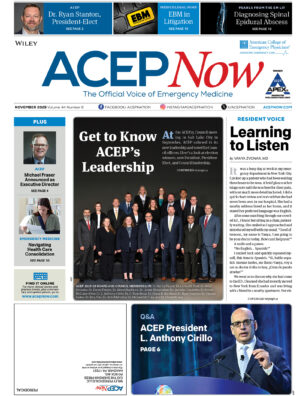On June 28, 2017, the ACEP Board of Directors approved a clinical policy developed by the ACEP Clinical Policies Committee on critical issues in the emergency department management of patients needing reperfusion therapy for acute ST-segment elevation myocardial infarction (STEMI). This policy is a revision to the 2006 ACEP clinical policy on the same topic. This revised policy, published in the November issue of Annals of Emergency Medicine, can be found on the ACEP website and has been submitted for inclusion in the National Guideline Clearinghouse.1
Explore This Issue
ACEP Now: Vol 36 – No 12 – December 2017Timely percutaneous coronary intervention (PCI) has become the standard treatment for acute STEMI. Only a minority of hospitals in the United States are PCI capable, and even fewer can provide 24-7 availability of this intervention. Acute STEMIs warrant emergent treatment. Rapid restoration of perfusion to the infarct-related coronary artery by either PCI or fibrinolytics is paramount to achieve the best possible outcome for the patient. The treatment benefit of timely fibrinolytic therapy, versus delayed PCI, must be considered in determining which mode of reperfusion therapy is best for the patient with acute STEMI. Patients with acute STEMI and contraindications to fibrinolytic therapy are not appropriate for fibrinolytic treatment.
The policy focuses on three critical questions regarding the evaluation and management of adult emergency department patients needing reperfusion therapy for acute STEMI. A systematic review of the evidence was conducted, and the committee made recommendations (A, B, or C) based on the strength of evidence (see Table 1). This clinical policy underwent internal and external review during a 60-day open-comment period where comments were received from emergency physicians, cardiologists, individual members of the American College of Cardiology Foundation/American Heart Association, a patient representative, and members of ACEP’s Medical-Legal Committee. These responses were used to refine and enhance this clinical policy.
Critical Questions
- In adult patients having a STEMI, are there patients for whom treatment with fibrinolytic therapy decreases the incidence of major adverse cardiac events (MACE) when PCI is delayed?
Patient Management Recommendations
- Level A recommendations: None specified.
- Level B recommendations: Fibrinolytics may be administered to patients when door-to-balloon (D2B) time is anticipated to exceed 120 minutes.
- Level C recommendations: A dose reduction should be considered when administering fibrinolytics to patients age 75 years or older.
- In adult patients having a STEMI, does transfer to a PCI center decrease the incidence of MACE?
Patient Management Recommendations
- Level A recommendations: None specified.
- Level B recommendations: To decrease the incidence of MACE, patients with STEMI should be transferred to a PCI-capable hospital as soon as possible.
- Level C recommendations: None specified.
- In adult patients undergoing reperfusion therapy, should opioids be avoided to prevent adverse outcomes?
Patient Management Recommendations
- Level A recommendations: None specified.
- Level B recommendations: None specified.
- Level C recommendations: Because safety has not been established, clinical judgment should be used in deciding whether to provide or withhold morphine in patients undergoing reperfusion therapy.
Management of patients with acute STEMI in the emergency department can be challenging when PCI is not immediately available at the hospital where the patient initially presents. The administration of fibrinolytics to decrease the incidence of MACE should be considered when there is an anticipated prolonged delay from the time of initial presentation to PCI. Another topic discussed in this policy is the use of morphine in STEMI patients. Based on the committee’s review, the risk of prescribing morphine in patients suffering from an acute STEMI is unclear at this time.
Reference
- American College of Emergency Physicians Clinical Policies Subcommittee (Writing Committee) on Reperfusion Therapy for Acute ST-Segment Elevation Myocardial Infarction, Promes SB, Glauser JM, et al. Clinical policy: emergency department management of patients needing reperfusion therapy for acute ST-segment elevation myocardial infarction. Ann Emerg Med. 2017;70(5):724-739.
Dr. Promes is professor and chair of the department of emergency medicine at Penn State Health Milton S. Hershey Medical Center in Hershey, Pennsylvania.
Pages: 1 2 | Multi-Page





No Responses to “ACEP Clinical Policy on Emergency Department Management of Patients Needing Reperfusion Therapy for Acute ST-Segment Elevation Myocardial Infarction”